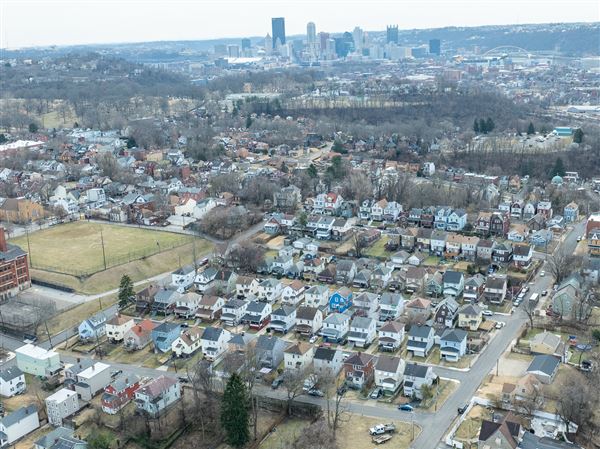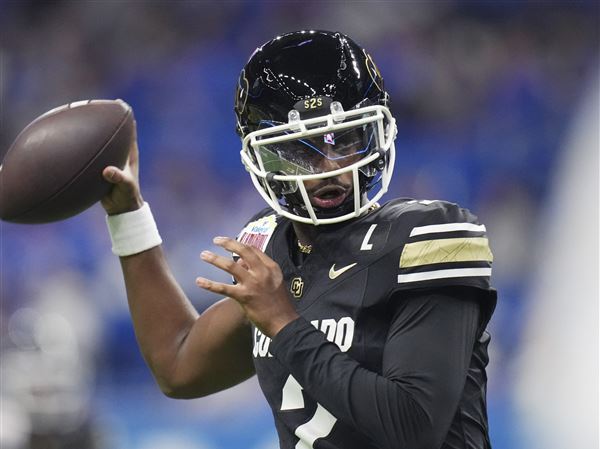Twelve miles south of Pittsburgh in South Park, near the black-and-gold playground and up a winding hill lies a pasture.
Here is where the buffalo still roam.
"A lot of people are surprised," said John Doyle, South Park's naturalist.
But there they are, and there they were on a not all cloudy day this week, 16 strong, including two calves born in April. In the 2,013-acre park, which includes biking and running trails, a golf course and a wave pool, the bison have been an attraction for more than 85 years.
And they will remain, since Allegheny County Council in 2001 passed a motion forbidding the bison from moving out of South Park. The location may move slightly, however, because Mr. Doyle expects plans for a newly designed corral adjacent to the current corral to move forward in the next year or so.
"People definitely love them," said Mr. Doyle, who has worked with South Park for 33 years, noting a nearby shopping center has adopted the bison as its emblem.
As Mr. Doyle spoke, a handful of groups wandered up to the double fenced area to peer at the bison, which were lying down or moving slowly in the heat of the day. The South Park game preserve is free to visitors and open all day.
It may be unique, now, to see buffalo in Pennsylvania, but it hasn't always been.
"It's not like they are an exotic animal or anything for this area," Mr. Doyle said.
In fact, when European explorers first arrived, about 50 million bison roamed North America, according to the Bronx Zoo in New York, where the American Bison Society was founded.
The forming of the United States -- and the westward expansion -- exacted a cost on the bison population, and in the early 1900s, bison from the Bronx Zoo were sent west. About 20,000 wild bison, which can live up to 40 years, now roam the Western United States, according to the Bronx Zoo.
In South Park, it was not the Bronx Zoo that brought the buffalo, but the Allegheny County commissioners, who in the late 1920s were devising a park system.
"In those early experimental days it seemed obvious that parks should have wild animals, and that the ideal caretakers or curators of wildlife would be real Indians," wrote J. Ray Gangewere in a 1986 article in Carnegie Magazine.
The county commissioners brought two tribes of Native Americans from a Montana reservation, with Chief Big Beaver and his tribe living in North Park and Chief Wild Eagle living in South Park, the Carnegie Magazine story said. The bison came from Colorado, Mr. Doyle said.
Thirty-six of them were divided among the two parks, but it was a short-lived set-up. In North Park, the Native Americans used the bison for food and clothing and were asked to leave, the magazine story said. In South Park, the Native Americans left on their own because they did not like Pittsburgh winters.
The bison, however, remained.
Mr. Doyle doubts any of the current bison are related to the original bloodline from Colorado, since the county has long sold and traded bison with other ranchers, mostly in Pennsylvania and Ohio, to avoid inbreeding. He sells or trades bison about every other year, and plans to do so this year. Expenses during 2012 for the game preserve, not including personnel costs, included $20,245 for feed, $2,815 for utilities, $500 for veterinarian and $85 for licensing.
Currently, there are seven females and seven males, plus two male calves, ranging in age from a few months to 13 years old. They stand about five feet tall, with the females between 1,000 and 1,500 pounds and the males between 1,500 and 2,000.
The number of bison in South Park peaked in 1946 at 32. Mr. Doyle prefers to limit the number to 10 to 12, due to both the space available and conflicts among the males to become the herd bull.
One of those conflicts was on display Monday morning, when park workers had separated a male into an adjacent pasture because he was "being beat up" for unknown reasons by two other males. He had been given medication for scratches and was recovering well, Mr. Doyle said.
For the past 17 years, Greg Hecker, South Park's animal keeper, has watched over the bison, feeding them hay and feed and corn in the mornings. Mr. Hecker spends much of his time inspecting and repairing fences, since the bison often brush against them. There have been two escapes in 85 years, Mr. Doyle said, though both were before he started as manager. The bison escaped once because they were spooked by fireworks and another time during a snowstorm. The park has an emergency response plan for an escape.
Mr. Doyle, who has been studying new designs for enclosures, said he anticipates South Park could move towards building a new corral in the next year, in part to put the bison on flatter ground and to make it easier when the staff or veterinarians administer tests or medicine. The animals remain outside in all weather; a three-sided shed is on the grounds, but Mr. Doyle said he's only seen them use it once.
As the bison lounged in their pasture Monday morning, Mr. Hecker said he can tell that the bison recognize him, especially when he comes by with treats.
"Apples and pears are their weaknesses," he said. "They'll follow you anywhere if you've got a bucket of apples."
First Published: June 26, 2013, 12:15 a.m.















